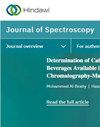Monitoring Sea Ice in Liaodong Bay of Bohai Sea during the Freezing Period of 2017/2018 Using Sentinel-2 Remote Sensing Data
IF 2.1
4区 化学
Q4 BIOCHEMICAL RESEARCH METHODS
引用次数: 4
Abstract
It is of great significance to monitor sea ice for relieving and preventing sea ice disasters. In this paper, the growth and development of sea ice in Liaodong Bay of Bohai Sea in China were monitored using Sentinel-2 remote sensing data during the freezing period from January to March in 2018. Based on the comprehensive analysis of the spectral characteristics of seawater and sea ice in visible bands, supplemented by the Normalized Difference Snow Index (NDSI) and the Normalized Difference Vegetation Index (NDVI), we proposed a new method based on decision tree classification for extracting sea ice types in Liaodong Bay of Bohai Sea. Using the remote sensing data of eight satellite overpasses acquired from Sentinel-2A/B satellites, the distribution and area of the different sea ice types in Liaodong Bay during the freezing period of 2017/2018 were obtained. Compared with the maximum likelihood (ML) classification method and the support vector machine (SVM) classification method, the proposed method has higher accuracy when discriminating the sea ice types, which proved the new method proposed in this paper is suitable for extracting sea ice types from Sentinel-2 optical remote sensing data in Liaodong Bay. And its classification accuracy reaches 88.05%. The whole process of evolution such as the growth and development of sea ice in Liaodong Bay during the freezing period from January to March in 2018 was monitored. The maximum area of sea ice was detected on 27 January 2018, about 10,187 km2. At last, the quantitative relationship model between the sea ice area and the mean near-surface temperature derived by MODIS data in Liaodong Bay was established. Through research, we found that the mean near-surface temperature was the most important factor for affecting the formation and melt of sea ice in Liaodong Bay.基于Sentinel-2遥感数据的2017/2018冰冻期辽东湾海冰监测
海冰监测对缓解和预防海冰灾害具有重要意义。利用2018年1 - 3月冰冻期Sentinel-2遥感数据,对中国渤海辽东湾海冰的生长发育进行了监测。在综合分析海水和海冰可见光波段光谱特征的基础上,结合归一化差雪指数(NDSI)和归一化差植被指数(NDVI),提出了一种基于决策树分类的渤海辽东湾海冰类型提取新方法。利用Sentinel-2A/B卫星获取的8个卫星立交桥遥感数据,分析了2017/2018年冰冻期辽东湾不同海冰类型的分布和面积。与最大似然(ML)分类方法和支持向量机(SVM)分类方法相比,本文方法在区分海冰类型方面具有更高的精度,证明了本文方法适用于从辽东湾Sentinel-2光学遥感数据中提取海冰类型。分类准确率达到88.05%。对2018年1 - 3月封冻期辽东湾海冰生长发育等演变全过程进行了监测。2018年1月27日探测到的海冰面积最大,约为10187平方公里。最后,利用MODIS数据建立了辽东湾海冰面积与平均近地表温度的定量关系模型。通过研究发现,平均近地表温度是影响辽东湾海冰形成和融化的最重要因素。
本文章由计算机程序翻译,如有差异,请以英文原文为准。
求助全文
约1分钟内获得全文
求助全文
来源期刊

Journal of Spectroscopy
BIOCHEMICAL RESEARCH METHODS-SPECTROSCOPY
CiteScore
3.00
自引率
0.00%
发文量
37
审稿时长
15 weeks
期刊介绍:
Journal of Spectroscopy (formerly titled Spectroscopy: An International Journal) is a peer-reviewed, open access journal that publishes original research articles as well as review articles in all areas of spectroscopy.
 求助内容:
求助内容: 应助结果提醒方式:
应助结果提醒方式:


